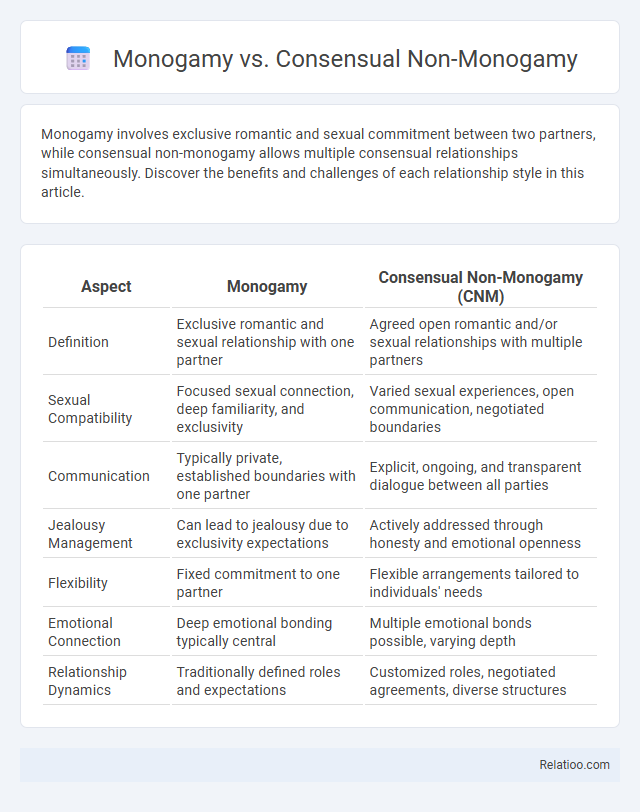Monogamy involves exclusive romantic and sexual commitment between two partners, while consensual non-monogamy allows multiple consensual relationships simultaneously. Discover the benefits and challenges of each relationship style in this article.
Table of Comparison
| Aspect | Monogamy | Consensual Non-Monogamy (CNM) |
|---|---|---|
| Definition | Exclusive romantic and sexual relationship with one partner | Agreed open romantic and/or sexual relationships with multiple partners |
| Sexual Compatibility | Focused sexual connection, deep familiarity, and exclusivity | Varied sexual experiences, open communication, negotiated boundaries |
| Communication | Typically private, established boundaries with one partner | Explicit, ongoing, and transparent dialogue between all parties |
| Jealousy Management | Can lead to jealousy due to exclusivity expectations | Actively addressed through honesty and emotional openness |
| Flexibility | Fixed commitment to one partner | Flexible arrangements tailored to individuals' needs |
| Emotional Connection | Deep emotional bonding typically central | Multiple emotional bonds possible, varying depth |
| Relationship Dynamics | Traditionally defined roles and expectations | Customized roles, negotiated agreements, diverse structures |
Understanding Monogamy: Definitions and Traditions
Monogamy traditionally refers to a committed relationship between two individuals, emphasizing exclusivity and emotional fidelity. Your understanding of monogamy often aligns with cultural and societal norms that prioritize lifelong partnership and legal recognition. Recognizing these definitions highlights the contrast with consensual non-monogamy, where multiple partners are openly acknowledged and agreed upon.
What is Consensual Non-Monogamy?
Consensual non-monogamy (CNM) is a relationship structure where all partners agree to engage in multiple romantic or sexual relationships simultaneously, emphasizing transparency and mutual consent. This contrasts with monogamy, which involves exclusive romantic and sexual commitment between two individuals. CNM includes various forms such as polyamory, open relationships, and swinging, each defined by the specific boundaries and agreements established by the participants.
Historical Perspectives on Relationship Structures
Monogamy, rooted in ancient societal norms, has historically dominated many cultures as the primary relationship structure, often linked to legal and religious frameworks. Consensual non-monogamy, encompassing practices such as polyamory and open relationships, challenges these conventions and has gained visibility through anthropological studies revealing its prevalence in diverse indigenous cultures. The evolving historical perspectives highlight a shift from rigid monogamous paradigms toward more inclusive understandings of relational diversity and autonomy.
Psychological Benefits and Challenges of Monogamy
Monogamy offers psychological benefits such as emotional security, deep attachment, and a clear relational commitment that can enhance trust and reduce jealousy. However, it can also present challenges like potential emotional stagnation, unmet needs for novelty, and pressure to fulfill multiple roles within a single relationship. Understanding these dynamics helps You navigate the complex interplay of attachment, communication, and personal growth in monogamous partnerships.
The Dynamics of Consensual Non-Monogamy
Consensual Non-Monogamy (CNM) involves multiple partners with mutual agreement, creating diverse relational dynamics centered on communication, trust, and boundary-setting. Unlike monogamy's exclusive partnership model, CNM requires ongoing negotiation and emotional intelligence to navigate jealousy and ensure all parties feel valued and respected. Understanding these dynamics helps you cultivate healthy, fulfilling connections that align with your relationship preferences and personal values.
Communication and Boundaries in Both Models
Effective communication and clearly defined boundaries are crucial in both monogamy and consensual non-monogamy to maintain trust and emotional well-being. In monogamous relationships, partners often establish exclusivity and mutual expectations, while consensual non-monogamy requires ongoing dialogue about multiple connections, consent, and individual limits. You must prioritize honest conversations and respect each person's boundaries to ensure relationship satisfaction regardless of the chosen model.
Addressing Common Myths and Misconceptions
Monogamy is often mistakenly viewed as the only path to a successful relationship, while consensual non-monogamy (CNM) is unfairly associated with dishonesty or lack of commitment, despite both models requiring clear communication and trust. You can challenge myths such as CNM being inherently unstable or monogamy guaranteeing emotional fulfillment by understanding that satisfaction depends on mutual respect and agreed-upon boundaries. Research shows that both monogamous and CNM relationships can thrive when partners prioritize transparency and emotional honesty.
Impact on Emotional Satisfaction and Intimacy
Monogamy tends to foster emotional satisfaction and intimacy through exclusivity and deep emotional bonds between partners. Consensual non-monogamy (CNM), including forms like polyamory and open relationships, emphasizes communication and trust, which can enhance emotional satisfaction by allowing diverse intimate connections. Research indicates that both monogamous and CNM relationships can achieve comparable levels of emotional fulfillment and intimacy when expectations and boundaries are clearly defined and respected.
Societal Acceptance and Cultural Influences
Societal acceptance of monogamy remains high due to longstanding cultural norms and legal frameworks that support exclusive pair bonding. Consensual non-monogamy (CNM), including polyamory and open relationships, experiences growing visibility but faces stigma rooted in traditional values and misconceptions about relationship stability. Cultural influences play a critical role in shaping attitudes, with Western societies showing increasing openness to CNM, while many non-Western cultures maintain conservative views favoring monogamous unions.
Choosing What Works: Personal and Relational Considerations
Choosing the relationship style that aligns with your values and needs involves assessing both personal desires and relational dynamics. Monogamy offers exclusivity and simplicity, while consensual non-monogamy (CNM) provides opportunities for connection beyond traditional boundaries, requiring clear communication and trust. Your decision impacts emotional well-being, relationship satisfaction, and compatibility, making honest self-reflection and open dialogue with partners essential for finding what truly works.

Infographic: Monogamy vs Consensual Non-Monogamy
 relatioo.com
relatioo.com